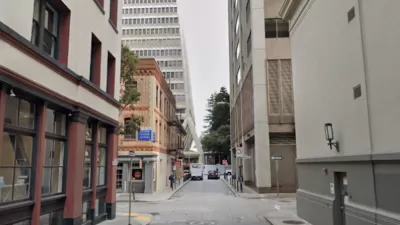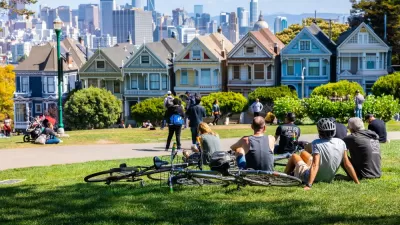San Francisco building codes encouraged the creation of privately-owned, publicly-accessible spaces across the downtown. These spaces have gone underused and are little understood. A new report from SPUR attempts to clear the fog.
"The shortage of public spaces in San Francisco's downtown has long been compounded by the fact that the urban geography of privately owned public open spaces (POPOS) makes them hard to find and even harder to enjoy. San Francisco Planning and Urban Research (SPUR) last week released a report that details all of downtown's POPOS, complete with a printable map (PDF), and makes recommendations on how to improve access and amenities.
San Francisco's first privately owned, publicly accessible park was constructed at the base of the Transamerica building in the late 1960s. At that time, building codes neither required nor encouraged development of public space at street level, and accordingly most office towers were built right to the edge of the property. The few exceptions were in buildings where developers sought density and height bonuses and created public space as a condition for approval.
In the 1985 Downtown Plan the city codified the conditions under which developers had to construct publicly accessible open spaces, which could be as diverse as plazas, greenhouses, or atriums, but had to comply with standards of landscaping, design, seating, and bathrooms. Yet, the city made no effort to provide information about the plazas in aggregate."
FULL STORY: Unlocking San Francisco’s Privately Owned Public Open Spaces

Alabama: Trump Terminates Settlements for Black Communities Harmed By Raw Sewage
Trump deemed the landmark civil rights agreement “illegal DEI and environmental justice policy.”

Study: Maui’s Plan to Convert Vacation Rentals to Long-Term Housing Could Cause Nearly $1 Billion Economic Loss
The plan would reduce visitor accommodation by 25% resulting in 1,900 jobs lost.

Planetizen Federal Action Tracker
A weekly monitor of how Trump’s orders and actions are impacting planners and planning in America.

Wind Energy on the Rise Despite Federal Policy Reversal
The Trump administration is revoking federal support for renewable energy, but demand for new projects continues unabated.

Passengers Flock to Caltrain After Electrification
The new electric trains are running faster and more reliably, leading to strong ridership growth on the Bay Area rail system.

Texas Churches Rally Behind ‘Yes in God’s Back Yard’ Legislation
Religious leaders want the state to reduce zoning regulations to streamline leasing church-owned land to housing developers.
Urban Design for Planners 1: Software Tools
This six-course series explores essential urban design concepts using open source software and equips planners with the tools they need to participate fully in the urban design process.
Planning for Universal Design
Learn the tools for implementing Universal Design in planning regulations.
Caltrans
Smith Gee Studio
Institute for Housing and Urban Development Studies (IHS)
City of Grandview
Harvard GSD Executive Education
Toledo-Lucas County Plan Commissions
Salt Lake City
NYU Wagner Graduate School of Public Service





























